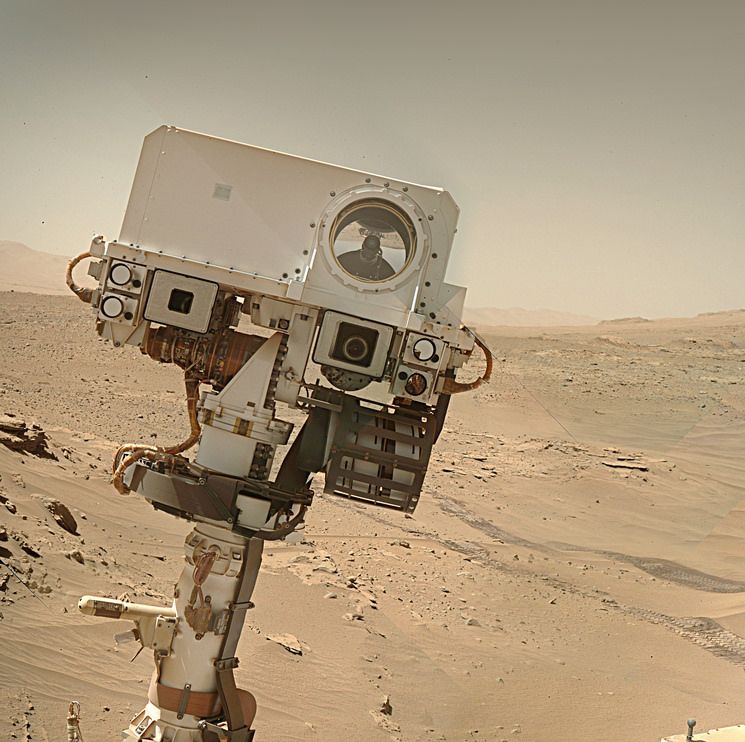A Royal Birthday Celebration at Kings Canyon - Curiosity Rover Blog for Sols 4263-4265
Earth planning date: Friday, Aug. 2, 2024
Prepare your party poppers, horns, and confetti! On Aug. 6 (EDT), after 4,265 Martian sols since Curiosity first landed in Gale Crater, the rover will be turning 12 years old. I still remember the excitement of watching Curiosity’s landing back when I started high school. Now, as a “Keeper of the Plan” for the Geology and Mineralogy theme group, I have the incredible opportunity to be part of this mission. To mark the end of the 12th year, Curiosity is currently parked within a large valley called Gediz Vallis, all primed and ready to drill “Kings Canyon” (pictured).
The previous plan involved conducting a preload test in Drill Sol 1, to ensure we could drill safely. The test was successful, confirming that Kings Canyon is safe to drill! The team was also happy with the chemical composition data from the APXS (Alpha Particle X-ray Spectrometer) results, so we are all set to drill a new king!
On the first sol, we’ll conduct Drill Sols 2 and 3, where the actual drilling will take place and the drilled material will be subsequently characterized. Alongside drilling, we also plan to capture a MAHLI (Mars Hand Lens Imager) image of a relatively peaceful target called “RAGE.” (This target is the site where the rover will later perform the RAGE activity to clean up after drilling.) On the second sol, we’ll perform a LIBS (Laser Induced Breakdown Spectrometer) analysis on “Lake Eleanor,” a rock crushed by Curiosity’s wheel, revealing light-toned material. Additionally, we will conduct a ChemCam passive observation on a section of the Gediz Vallis channel floor.
The third sol is packed with scientific activities. We’ll conduct a LIBS on “Lyell Glacier,” a rock with different colored coatings to compare with dark-toned coatings seen by the Perseverance rover. ChemCam will take the opportunity to capture a long-distance Remote Micro-Imager (RMI) shot of an arm of “Milestone Peak,” which is full of gray rocks aligned in a slightly different direction from the rest of the ridge within the center of Gediz Vallis. We also plan to capture four Mastcam mosaics: one of the southern section of a large hill called “Kukenan” and three mosaics documenting the different textures, structures, and lithologies of the deposits within the valley floor. Furthermore, a ChemCam Passive Sky observation and atmospheric monitoring activities in the morning are also on the agenda.
As we prepare for these exciting activities, the anticipation builds for Curiosity’s 12th birthday. Here’s to many more years of exploration and discovery on the Red Planet!
Written by Amelie Roberts, Ph.D. candidate at Imperial College London
Source for this blog (with all the links and the original raw image): https://science.nasa.gov/blogs/sols-4263-4265-a-royal-birthday-celebration-at-kings-canyon/
These blog updates are provided by self-selected Mars Science Laboratory mission team members who love to share what Curiosity is doing with the public.
Dates of planned rover activities described in these reports are subject to change due to a variety of factors related to the Martian environment, communication relays and rover status.
Image credits: NASA/JPL-Caltech
Happy birthday!
That’s in Earth-years, right? Do we also celebrate birthdays in Mars-years?
Yes, that’s blog is referring to Earth-years - Some (like me) also celebrate birthdays in Mars-years, but they are not normally celebrated by the team in formal News releases, but they are usually mentioned in Curiosity’s mission blogs. Probably less celebrated because the Mars date system is sort of complicated.
IIRC - The rover celebrated 6 Martian Years on November 18, 2023.
the Mars date system is sort of complicated
Using Earth UTC is probably fine for now, but in the far future, Martian colonists might want an easier way to track when to plant crops and such. Is there an established Mars date system yet?
AFAIK - No internationally agreed standard, but a bunch of formats have been proposed.
They do have some elements like Local Mars Solar time (LMST) that can be calculated for any spot on Mars, these have been used by a number of nations that have sent hardware to the surface
There’s an in-depth Wikipedia page on Timekeeping on Mars, it covers things like proposed date systems as well as calendars. I would assume that the first human settlers to arrive on the planet Mars would select the system that suited them best before departure. I also assume any settlers that arrive later would likely follow what is already in place, rather than use a different system.

